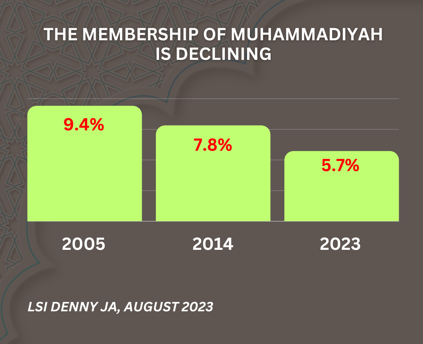Why Has The Muhammadiyah Voter Profile Shrunk Over Time?
The decline in the percentage of Muhammadiyah followers in Indonesia despite the expansion of their charitable efforts.
POLITICS
Ekspresi Data Denny J.A
9/23/20232 min read


What gives us the impression that the percentage of Muhammadiyah followers has been declining? Despite the fact that Muhammadiyah's charitable efforts continue to expand!
Muhammadiyah has numerous charitable initiatives. They manage 163 universities, 23,000 kindergartens, and 348 Islamic boarding schools. Additionally, Muhammadiyah has 117 hospitals and thousands of elementary and secondary schools.
We begin with the data. This is Denny JA's August 2023 LSI survey, which has been enriched by surveys from 2014 and 2005.
Since 2005, we have been polling the general population on the query, "Do you feel like you are a part of the big Muhammadiyah family?" Which stated "Yes, we are part of Muhammadiyah" in 2005 was 9.4%. In 2014, the percentage dropped to 7.8%. Now in 2023, the percentage again decline to 5.7%. In the past eighteen years, the number of people who identify as Muhammadiyah has decreased by nearly half.
In 2004, over fifty percent of Muhammadiyah adherents stated, "Yes, we are members of Partai Amanat Nasional (PAN), the National Mandate Party," regarding their political ambitions. Currently, however, only 17.5% of individuals claim to be PAN members. The remaining are dispersed to various parties. Members of Muhammadiyah convey their political ambitions in a significantly more diverse manner, no longer favouring PAN as their primary party of choice.
See the political aspirations data here.
What is the demographic composition of the inhabitants of Muhammadiyah?
If there are more graduates from junior high and lower at Nahdlatul Ulama (NU), then Muhammadiyah consumes more scholarly works. Up to 30 percent of residents in Muhammadiyah have completed high school.
The majority of individuals in Nahdlatul Ulama earn less than 2 million rupiah, whereas in Muhammadiyah, 40% earn between 2 and 4 million rupiah. The majority of Muhammadiyah voters are better educated and earn more money than the majority of NU residents.
Over 77% of the population of NU resides in Java, whereas only 60% of the population of Muhammadiyah resides in Java. On numerous islands, Muhammadiyah's inhabitants are more dispersed. There are as many as 35 percent of Muhammadiyah residents in Sumatra.
See the demographic data here.
How do Muhammadiyah adherents view the condition of their society?
67.5% of Muhammadiyah followers stated that religion and politics cannot be separated. This percentage exceeds the 50% of citizens in the NU.
Despite this, 95% of Muhammadiyah residents agree that Pancasila is the sole governing principle of the Indonesian government. Moreover, 82.5% of respondents stated that Islamic law should not serve as the premise for government.
See their views on important issues 1 here.
See their views on important issues 2 here.
Social Media Usage
The rate of participation in social media by Muhammadiyah citizens is also higher than that of NU citizens and the average Indonesian citizen.
As many as 90 percent of Muhammadiyah's residents own mobile phones. On average, less than eighty percent of Indonesians own mobile phones. 85 percent of the population of Muhammadiyah has internet access. On average, only 65 percent of Indonesians have access to the internet. Muhammadiyah inhabitants are more likely to use TikTok, Instagram, Facebook, and WhatsApp than NU residents and all Indonesians.
See their social media usage data here.
Why has the proportion of individuals claiming to be Muhammadiyah members decreased over time?
This is assignment for more than just the administrators of Muhammadiyah. This is also food for thought for those of us who care about modern, progressive mass organizations like Muhammadiyah.
***
Ekspresi Data Denny J.A, 2023
